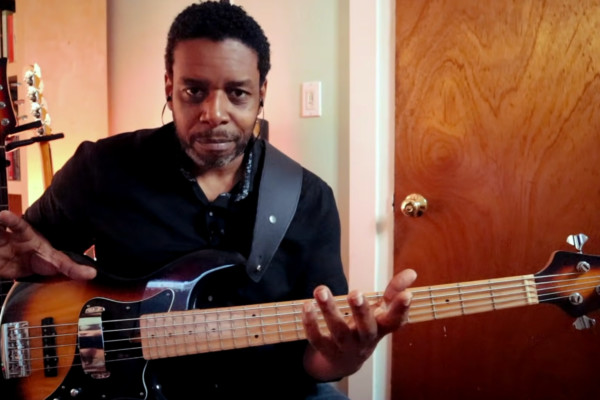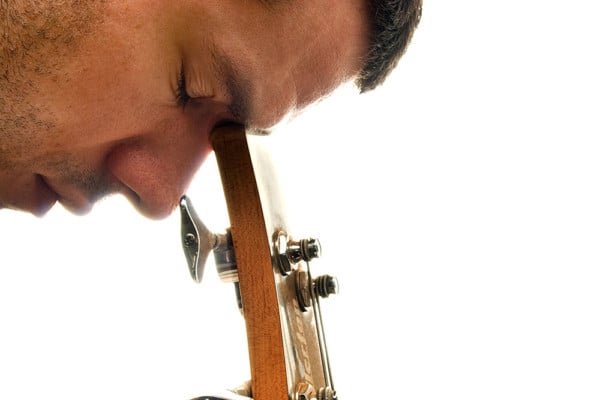Getting Over Extended Range (and Other Musical) Ruts

Q: I’ve been playing bass for many years, and started playing the 6-string bass only about six years ago. I’m currently stuck in a dormant sludge of un-creativity! Any thoughts on who offers a good 6-string finger exercise, scale patterns, a book or even a good video? I can’t seem to get out of the same old riffs… I’m not a beginner or novice player. I have even taught fingering and modes to new players. I’m just STUCK! Any advice would be greatly appreciated.
A: My first thought was to send you a link to an article I wrote on climbing out of ruts earlier this month.
However, you specifically mention playing a 6-string. So I thought that this might be an opportunity to ponder ways players who are just starting to add range to their instrument (5-strings and beyond) can take what they already work on and expand the concepts of an exercise.
More of the same, but beefier
One of the benefits of having a low B string (beyond having a note below open E) is being able to play things on a thicker string and further up the neck (both of which add “beef” or thickness to the note). Practice playing things you might normally play or practice on the first five frets of the E string, and move them to the middle of the neck on the B string.
Notice how the tone is different? This is one of the many reasons why it is important to get to know your fretboard well in the middle of the neck (typically, a bit of a nebulous area for many players). Moving a line down there can really add some bottom to the sound. For example, when playing Latin music, I recommend keeping the sound of a “Baby Bass” in your head. In order to try and emulate that sound, you will tend to palm mute, play with your thumb and you’ll want to also play everything in the middle of the neck. A B string can be worth it just for that ability alone.
In addition, take an exercise, scaler pattern, reading exercise (or whatever it may be), and play it in different parts of the neck. That’s much more challenging than you might anticipate. It is also phenomenal for your internalization of the fretboard.
Hyper-exploration of intervallic shapes
With more range comes the ability (especially on a 6-string or above) to play with shapes on the fretboard. I fully believe in the exploration of shapes on the fretboard. Aside from being one trick in your bag for soloing, it also – and more important – it helps you to connect the visual (shape) with the aural (sound). You get to understand how a given shape or pattern will sound, and hearing what you are going to play before you play it is a huge part of your development. When you can put the ears before the brain or the fingers, you really start making music.
Play around with repeating intervals:
What does it sound like when you play nothing but Major thirds from the lowest note to the highest note?
How are you going to pattern that in order to travel up (or down) the neck? (Because, yeah, you could just play a diagonal line and have all Major thirds, but what if you alternated between diagonal lines and a leap of four frets? Way more range available, right?)
Try this with every interval and then move on to combining more than one interval, such as 3rds and 6ths.
I use to do this very systematically. I would do two intervals, then three, then four, and so on… trying to hit all combinations. Whenever I’d stumble upon a relationship that perked my ear, I’d explore it fully and try to play it every possible way, then add chromatic approaches.
Really get inside of the exercise and explore it fully.
Chords
Get really inside of chord shapes as well. Make sure that you can play any root position chord shape that spans from between two strings, and as many strings as you have on your instrument.
Now, all inversions!
Now, add extensions when applicable.
Now, try voice leading chord shapes through changes.
The key to any rut is quite often just a matter of getting a little creative and working on something new (which becomes something new and exciting). If you can think of something new, think of something old and flip it on it’s head and turn it inside out. This is one way in which great players come up with completely new ideas and things that haven’t been thought of before (not to mention finding your own “voice”).
Have fun!!
Readers, how do you work yourself out of musical ruts? Share your advice in the comments.
Photo by Damian Stevens
Have a question for Damian Erskine? Send it to [email protected]. Check out Damian’s instructional books, Right Hand Drive and The Improviser’s Path.




A rut or plateau is easy to fall into especially when you’ve been playing the same genre of music for a while and then writing songs that explore different areas. There are two ways I typically approach this. 4/4, or ‘common time’ is what most of us play and write in. Write out perhaps 16 bars of chord changes but do it in 5/4 instead. Then, play the same changes back in 4/4. Notice the difference in feeling and approach? Try ‘keeping it on the one’ in 5/4. It’s not as easy as it sounds. Secondly, when one gets locked into a particular style, we always tailor everything we do that way. Explore the entire scale. If you’re playing a simple I-III-V-VI verse or chorus, jump into previously uncharted waters and see what other notes in the given changes will work according to what you’re after. In other words, to climb out of your rut, build yourself a new ladder with the same materials.
Another way to get out of rut is to simply put your instrument down – do not be afraid! Don’t play the bass for a day, a week, a month, six months – whatever suits you. When you return, you’ll be amazed at how fresh the instrument sounds and feels, regardless of how many strings you prefer or whatever genre you play.
You need to study music, not finger wiggling. Excercises, scale patterns, books and videos will not change the fact that you have passed the point of diminishing returns with these methods. Were this not true, you would not be in a “rut”. You never get in a rut when you know how to play music. Learn to read, play music written for other instruments, say the note names out loud when you practice scales and arpeggios. Don’t pay for instruction from ANY source that does not teach these fundamentals. Ignoring the need to understand valid musical principals does not exempt you from being a mediocre player. Challenge yourself to learn music and stop playing the same non-musical stuff that got you where you are.
Learning to read music is one of the keys to growth. Music is a very developed art form and it has been handed down in written form for literally hundreds of years. It is tough to start but once you can read you will be one of but a handful of players in your area that can read music. To learn to read faster get a gig that requires you to read. Nothing like a gig to focus ones mind.
Also, gig with different people and styles. They can give you great ideas and you find interesting connections between styles.
If you have just been Doing your own thing and it’s wearing thin, read some music, from Bernstein to Ellington, Haydn to the Who, chick Corea to L’il Wayne. Variety of playing leads to creative thinking.
your an amazing player, with or without charts!
Amen — enjoy your attitude.